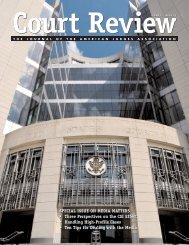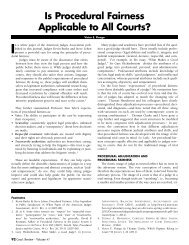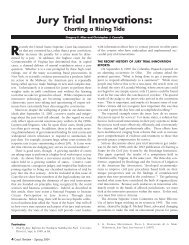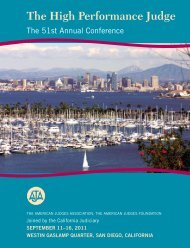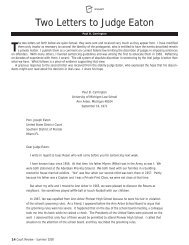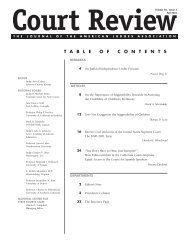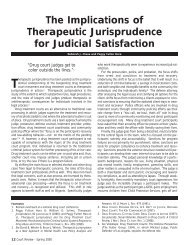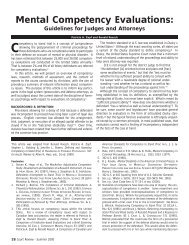The resourceguide... willc<strong>on</strong>tain effectivetechniques, toolsfor judges andcourt staff, bestpractices, andmodel courtprograms....individual unhappy withthe outcome, but twowho felt that they weregiven a fair shake by thesystem.” 4The c<strong>on</strong>ference alsomarked the release of a publicati<strong>on</strong>for members of thebranch that describes thegoals of the initiative anddefines procedural fairnesswithin the c<strong>on</strong>text of theCalifornia court system:<strong>Procedural</strong> fairness refers to court users’ percepti<strong>on</strong>sregarding the fairness and the transparency ofthe processes by which their disputes are c<strong>on</strong>sideredand resolved, as distinguished from the outcome oftheir cases. Percepti<strong>on</strong>s of procedural fairness arealso significantly affected by the quality of treatmentthey receive during every interacti<strong>on</strong> with the court.The perceived fairness of court outcomes is alsoimportant but is c<strong>on</strong>sistently sec<strong>on</strong>dary to howcourt users perceive their cases to have been handledand the quality of treatment they received.Court users’ percepti<strong>on</strong>s of procedural fairness aremost significantly influenced by four key elements:respect, voice, neutrality, and trust. 5The subject of procedural fairness set the t<strong>on</strong>e for the c<strong>on</strong>ferencethrough an opening plenary sessi<strong>on</strong> that featured alively Fred Friendly Seminars © Socratic dialogue <strong>on</strong> proceduralfairness and its impact <strong>on</strong> public trust and c<strong>on</strong>fidence in theCalifornia courts. In additi<strong>on</strong> to video vignettes that depictedthe complexities of achieving elements of procedural fairnessin a court setting, the Fred Friendly Seminars dialogue alsoemployed ficti<strong>on</strong>al judicial characters to represent differentvoices and approaches that exist within the branch. Arthur R.Miller, a professor at the New York University School of Law,moderated and led a diverse panel through a hypothetical scenarioin which three ficti<strong>on</strong>al trial judges in a California courtreflected differing views regarding procedural fairness.Both the plenary and a follow-up, targeted course <strong>on</strong> proceduralfairness designed for court leadership by Professor TomR. Tyler (New York University), focused <strong>on</strong> how judicial officersand attorneys can foster public understanding and trust inthe courts and also explored how the values associated withprocedural fairness support judicial branch independence andimpartiality.Resource Guide for the Courts <strong>on</strong> <strong>Procedural</strong> <strong>Fairness</strong>.Following the Bench Bar C<strong>on</strong>ference, initiative lead staff determinedthat a resource guide <strong>on</strong> procedural fairness would bestserve the courts in accomplishing branch goals. Programs andpolicies that explicitly reference procedural fairness c<strong>on</strong>ceptsare relatively new for many courts, and a comprehensivetoolkit would provide both a better understanding of proceduralfairness and applicable best practices for the courts.Through a competitive bidding process, the Center for CourtInnovati<strong>on</strong> (New York City) was chosen to work with the AOC<strong>on</strong> the development of the resource guide. Founded as a public/privatepartnership between the New York State UnifiedCourt System and the Fund for the City of New York, theCenter for Court Innovati<strong>on</strong> is a n<strong>on</strong>profit think tank that helpscourts and criminal justice agencies aid victims, reduce crime,and improve public trust in justice. In New York, the centerfuncti<strong>on</strong>s as the court system’s independent research and developmentarm, creating dem<strong>on</strong>strati<strong>on</strong> projects that test newideas. The center has collaborated <strong>on</strong> a number of other projectswith the California judicial branch, and we look forwardto working with their researchers in this endeavor.The resource guide, which is currently in the initial stagesof development, will c<strong>on</strong>tain effective techniques, tools forjudges and court staff, best practices, and model court programs—c<strong>on</strong>tentsthat are readily adaptable to court, educati<strong>on</strong>,and interactive Web envir<strong>on</strong>ments. Ultimately, the guide willhighlight a variety of strategies and programs that support thebranch policy to achieve procedural fairness in all types ofELEMENTRespectVoiceNeutralityTrustCOMMONCHALLENGECourt users may experiencea lack ofrespect because of culturaldifferencesCourt users may bedisappointed aboutthe length of timethey are able to speakto a judgeCourt users may bec<strong>on</strong>fused regardingdifferent outcomesthat may emerge fromfamily courtCourt users may havea hard time developingtrust if they try toavoid the legal systemaltogetherRECOMMENDATIONEducati<strong>on</strong>al programsthat reflect specific culturaldifferences or thatenhance court knowledgeabout cultural miscommunicati<strong>on</strong>sTools for court staff tohelp manage expectati<strong>on</strong>sand to educate thepublic about what toexpect in the courtroomGuides for court staff toexplain what occurs infamily court and whatopti<strong>on</strong>s exist to helpindividuals resolve theirmatterResources to help makecourt less intimidatingand to explain theimpartial role of thecourts and judges4. Chief Justice R<strong>on</strong>ald M. George, Plenary Address to the Bench BarC<strong>on</strong>ference (Sept. 26, 2007).5. JUDICIAL COUNCIL OF CALIFORNIA, PROCEDURAL FAIRNESS IN THECALIFORNIA COURTS 2 (2007), available at, http://www.courtinfo.ca.gov/programs/profair/documents/profair_brochure_092507.pdf.50 Court Review - Volume 44
cases. On its completi<strong>on</strong> in 2009, the guide will be distributedto every court in the state, will be available <strong>on</strong> the Web and inprint, and will further serve as a resource to develop educati<strong>on</strong>alcourses and to identify best practices for trial and appellatecourts.Following the model used for the public trust and c<strong>on</strong>fidenceassessment, which included surveys, interviews, andfocus groups, development of the resource guide <strong>on</strong> proceduralfairness will be an iterative process that solicits input fromcourt leadership, branch members, and the public (e.g., courtusers). An informal working group <strong>on</strong> procedural fairness hasbeen established at the AOC with a variety of representatives,and this group will work closely with the courts, c<strong>on</strong>sultants,and an editorial board composed of nati<strong>on</strong>al experts and leadersfrom the California courts.[T]he c<strong>on</strong>cept ofprocedural fairness[has] become moretangible to courtstaff and help[ed]them... to improvecourt interacti<strong>on</strong>sand the ultimateexperience of courtusers.Educating Stakeholders About <strong>Procedural</strong> <strong>Fairness</strong>. Theinitiative includes an important educati<strong>on</strong>al comp<strong>on</strong>ent, and avariety of activities have taken place to expand outreach andeducati<strong>on</strong> <strong>on</strong> procedural fairness. The educati<strong>on</strong>al sessi<strong>on</strong>s,originally designed by Professor Tyler and presented at theBench Bar C<strong>on</strong>ference, have been repurposed for stakeholders.These educati<strong>on</strong>al sessi<strong>on</strong>s present an opportunity to dispelcomm<strong>on</strong> misc<strong>on</strong>cepti<strong>on</strong>s regarding procedural fairness (e.g.,procedural fairness does not suggest that people are happy ifthey lose; however, using fair procedures makes it more likelythat a losing party will be willing to accept an adverse decisi<strong>on</strong>)and benefits (e.g., increased order compliance, acceptanceof the court as a legitimate authority, and improved c<strong>on</strong>fidencein the process by litigants).In particular, focusing <strong>on</strong> the elements of procedural fairness—respect,voice, neutrality, and trust—has been an importanttool in educati<strong>on</strong>al settings for members of the branch.The elements of procedural fairness are interdependent andinterrelated. However, it has been helpful to have workshopparticipants break into groups and discuss each element atlength, identify comm<strong>on</strong> challenges that exist for realizing theelement, and suggest soluti<strong>on</strong>s for meeting challenges. The followingtable gives some examples:The workshops offer judges, commissi<strong>on</strong>ers, mediators, andcourt staff a unique opportunity to identify comm<strong>on</strong> court usermispercepti<strong>on</strong>s, highlight areas of c<strong>on</strong>fusi<strong>on</strong> and breakdownsin communicati<strong>on</strong> between court staff and court users, anddevelop tools and strategies to meet public expectati<strong>on</strong>s andachieve procedural fairness. Course attendees may not have aninitial deep understanding of procedural fairness, however,most quickly and readily identify with procedural fairness inthe court setting <strong>on</strong>ce the elements are explained in depth. Thediscussi<strong>on</strong>s have allowed the c<strong>on</strong>cept of procedural fairness tobecome more tangible to court staff and help them identifywhat may be needed to improve court interacti<strong>on</strong>s and the ultimateexperience of court users.Presentati<strong>on</strong>s to various advisory committees of the JudicialCouncil—composed of judicial officers, court staff, and justicesystem partners—have been helpful to forge further collaborati<strong>on</strong>.A number of advisory committees (e.g., Access and<strong>Fairness</strong> Advisory Committee, Collaborative Justice CourtsAdvisory Committee) see a natural alignment between theirgoals for improved access and fairness in the courts, or problem-solvingcourts where litigantswould have more interacti<strong>on</strong>with a judge, with thegoals of the procedural fairnessinitiative. The committeeshave expressed interest indeveloping a formalized educati<strong>on</strong>almodule for newjudges and commissi<strong>on</strong>ers <strong>on</strong>the importance of proceduralfairness. This will be especiallyvaluable for bench officerswho work in high-volumecase venues such as familyand juvenile, small claims, and traffic. Assistant PresidingJudge Charles W. McCoy, Jr., Superior Court of Los AngelesCounty, has been particularly active in leading efforts to familiarizethe court’s new bench officers regarding the importanceand benefits of procedural fairness.Court administrative staff also supported development of aninteractive program <strong>on</strong> procedural fairness at the request of thebench of the Superior Court of Santa Clara County. Judge KevinBurke (Hennepin County, Minnesota, Fourth Judicial District)and Dr. R. Dale Lefever (Emeritus Faculty, University ofMichigan, Department of Family Medicine) worked closelywith Presiding Judge Catherine A. Gallagher and AssistantPresiding Judge Jamie A. Jacobs-May (Superior Court of SantaClara County) and presented the course in fall 2007. JudgeBurke and Dr. Lefever drew <strong>on</strong> their expertise in proceduralfairness and n<strong>on</strong>verbal communicati<strong>on</strong> to help the attendingjudges review their demeanor and style of interacti<strong>on</strong> from thebench. They did this by using videotape and feedback. A numberof Santa Clara judicial officers volunteered to be videotapedwhile they performed normal duties <strong>on</strong> the bench. It was madeclear to the participants that the workshop was not performancerelated but was designed simply as a developmental programto help the Santa Clara bench increase public trust andc<strong>on</strong>fidence. One-<strong>on</strong>-<strong>on</strong>e review and discussi<strong>on</strong> was followed bya group evening sessi<strong>on</strong> where a large number of the court’sbench officers discussed the video and how the public mightinterpret and receive a variety of approaches from the bench.Additi<strong>on</strong>al bench officers expressed interest after attending thegroup sessi<strong>on</strong>, and they also volunteered to later be videotapedand participate in <strong>on</strong>e-<strong>on</strong>-<strong>on</strong>e review and discussi<strong>on</strong> sessi<strong>on</strong>swith the c<strong>on</strong>sultants. In program evaluati<strong>on</strong>s, 84 percent of theparticipating officers recommended that it be repeated in theircourt at a future date. The AOC is c<strong>on</strong>sidering repeating thebench officer program in another volunteer court.In additi<strong>on</strong>, a number of courts within the state haverequested funding for <strong>on</strong>e-day programs for judges and courtstaff to help increase internal understanding and discussi<strong>on</strong> ofprocedural fairness and improve public trust and c<strong>on</strong>fidenceam<strong>on</strong>g their court users. To ensure cost efficiency, c<strong>on</strong>sistency,and effective delivery of these programs, the AOC will workwith the courts and educati<strong>on</strong>al c<strong>on</strong>sultants so that such programscan be repurposed and replicated in other courts.Measuring <strong>Procedural</strong> <strong>Fairness</strong>. Increased usage of theNati<strong>on</strong>al Center for State Courts (NCSC) CourTools © account-Court Review - Volume 44 51



